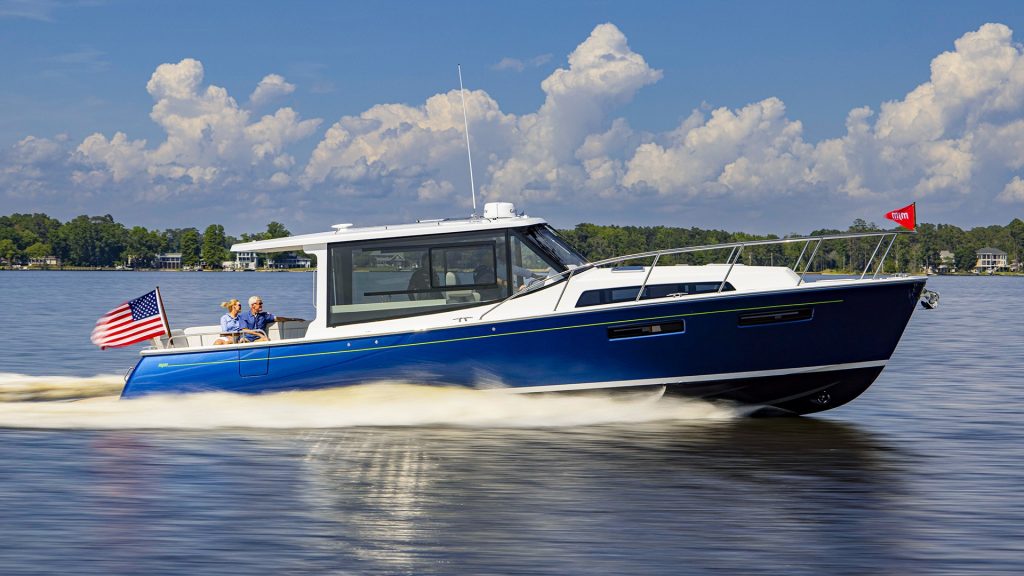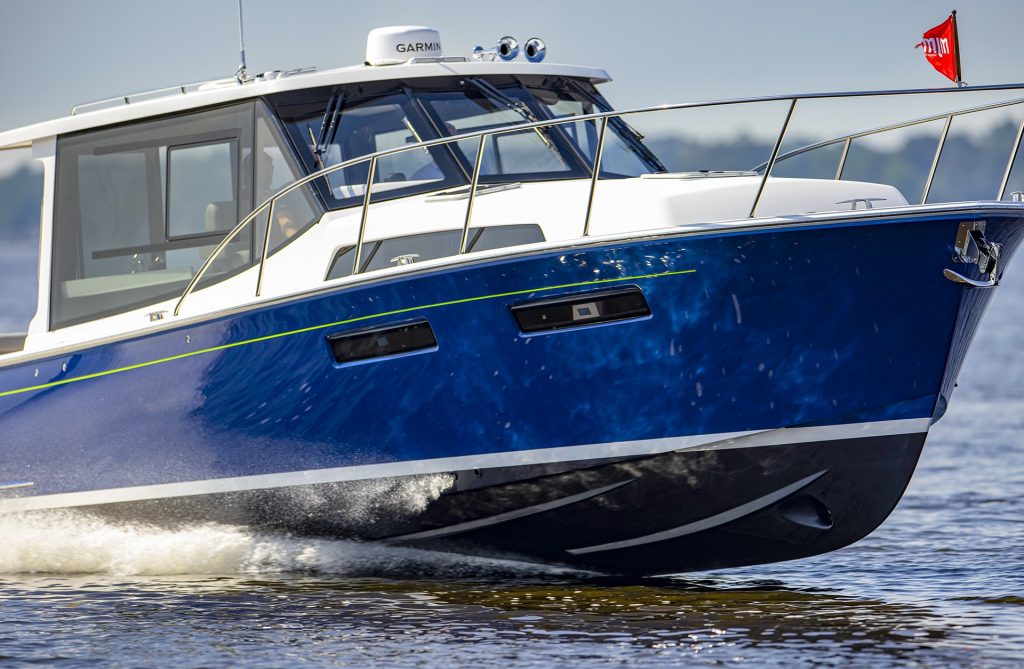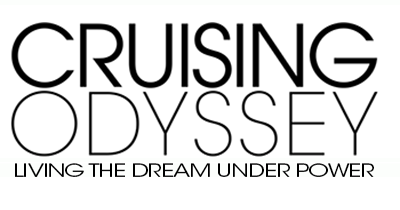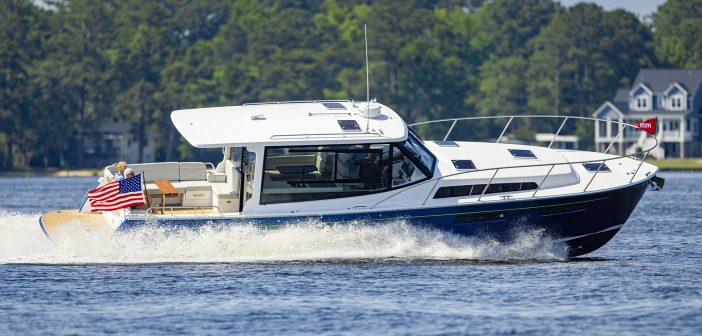By George Day
Part One: Running fast and efficiently on the Pamilco River
In early June, I travelled from Newport, Rhode Island, to Washington, North Carolina, to visit with our friends at MJM Yachts and to test drive the new MJM 42. Washington is an old southern town and port that sits on the edge of the Pamilico River. And, it is a boat building mecca.
It has lovely late 18th Century architecture –rebuilt after Northern troops burned the town during the Civil War—and a picturesque waterfront with several marinas and a waterfront park.
It was in a marina at the north end of town that I found Melissa Davidson, director of sales and marketing at MJM, and the rest of the MJM crew aboard the brand new 42. With its distinctive dark blue hull, slight reverse sheer line and a large cabin with huge windows, the 42 was definitely a sibling in the MJM family.
We stepped aboard and one of the crew switched on the genset to bring the boat alive. Standing on the hatch to the mechanical locker below I could barely hear the genset and had only a faint vibration underfoot.
Our skipper of the day was Reggie Fountain, Jr. who is a member of the Fountain family of boat builders that for decades built high-speed powerboats and race boats just across the river. Cruising Odyssey’s editor, Peter Jasnssen, while editing a different boating magazine, once drove a Fountain powerboat at 160 mph on this stretch of the Pamilco.
We weren’t going to go that fast today, but we were going to put the new 42 through its paces and we would be going as fast as any cruiser would ever need or want to go.
MJM builds four models. The MJM3 and MJM4 are day cruisers with large cockpits and an open seating areas in the bows and both have accommodations for overnighting. The MJM 35 and the new 42 are express cruisers created for owners and families who want to day cruise in comfort but also want to spend days or even a week or more living aboard and cruising the coasts.

Reggie fired up the twin Volvo D440s with DPI drives and we all had the same sensation created by the genset, the sound of the engines was seriously dampened by sound insulation. Reggie motored us through town and down a narrow channel to the middle of the Pamilco. Then, he pushed the throttles forward and the 42 began to show us what it can do.
The 42, like its siblings, has 18.5 degrees of deadrise –-V shape to the hull—that carries all the way aft. So, as the 42 accelerated, the bow did not rise as it gained speed but instead the hull remained flat on the water which meant it wasn’t digging a big hole in the water aft and thus wasn’t creating drag that would slow us down.
Also, MJM uses advanced boat building materials and techniques in all of their boats with the aim of making them as light as possible while also making them incredibly stiff and durable. It’s the weight factor that helps the boats achieve their noteworthy turns of speed.
With the throttles wide open, the Volvos ticked over at 3800 rpms and gave us a maximum boat speed of 46 knots. Riding on the hull’s deep V, the motion was as smooth as can be and it felt like we were running on rails. There was a small wind driven chop on the river that rat-a-tatted under us without the least sensation of pounding.
Reggie put the 42 through a series of high-speed figure eights turns and, again, the boat was as sure footed as if on rails. As we crossed our own wakes, much larger than the wind-driven chop, the 42 sliced through them like a hot knife through butter. This was reassuring when thinking of those inevitable days when you have to get home and the wind has kicked up from exactly the wrong direction.

After the figure eights, Reggie handed me the helm so I could get a feel for how the 42 actually drives at various speed and in various turns. I’ve driven lots of motorboats so I could tell within the first few seconds that the hull design, propulsion set up and steering with the DPI drives was a sophisticated combination.
The feel of the wheel was light but the response to each turn was immediate and positive. You know you have complete control even at full speed. You also feel that you could drive the 42 a high speed comfortably for hours if you wanted to make miles.
I had my fun and then we turned back toward Washington and started to work on just how efficient the 42 really is. At 3800 rpms, with the twin diesels, the Garmin instruments indicated that we were burning a gallon per mile. That’s going 46 knots.
Backing off to 3350 rpms, the boat slowed to 39 knots and the instrumentation indicated that we were now getting 1.3 miles to the gallon. If you have run and refueled big powerboats, you’ll appreciate that number.
Even better, you will like what you see when you throttle back to 3000 rpms. We were now cruising at 30 knots, which will be a comfortable speed for everyone on board and fast enough to make fine progress on a coastal run. And, the 42 was now getting 1.5 miles to the gallon.
Instead of the twin Volvos, the 42 can be equipped with twin 600-horsepower Mercury Verado outboards. Reportedly, these will add about five knots to the top speed. We did not test the outboard version so will hold evaluations for another day.
MJM likes to talk about the many great features in their yachts, and there are many, but to me, a secure, comfortable ride and excellent fuel efficiency at quite high speeds are game changers and huge differentiators.
Life Aboard
The 42 has spacious living spaces for entertaining friends and for a couple that wants to head off cruising for a few days. The cockpit’s bench settees will seat four or five comfortably around a small folding table.
The swim platform aft in the inboard version offers a large space for lounging and playing with water toys. In the outboard version, this becomes the engine mount and the inboard engine compartment becomes a huge storage area.
The salon has an efficient galley on the starboard side with two fridge drawers, a microwave, a convection stove top and galley sinks. The dinette will fit four and the co-pilot chair’s back folds forward to add another seat.
In the forward cabin, there is a centerline double berth with large drawers under it and two hanging lockers. The lounge area just aft has an L-shaped sofa with a small table. In a pinch, this could be a guest berth. The lounge and forward cabin are separated by a door for privacy.
Under the salon and behind the companionway steps, a second double berth is in what could be called the cave. This will be great for children or grandchildren.
The head is huge and has a separate shower that has a door to keep shower water contained.
A couple on their own will find the 42 a perfect size for summer getaways. And, it will be a fine platform for day cruising and entertaining friends and family.
During my visit to Washington, I had a chance to tour of the MJM factory and see how these remarkable boats are built. I’ll take you on that tour in Part Two next week.
MJM 42 Specifications
LOA 46’8”, LOD 42’7”, Beam 12’, Draft Engines down 36” (outboard), 42” (inboard), Displacement (light) 19,432 lbs., Fuel 475 (outboard), 350 (inboard), Air height (with radar) 9’9’.
www.mjmyachts.com




